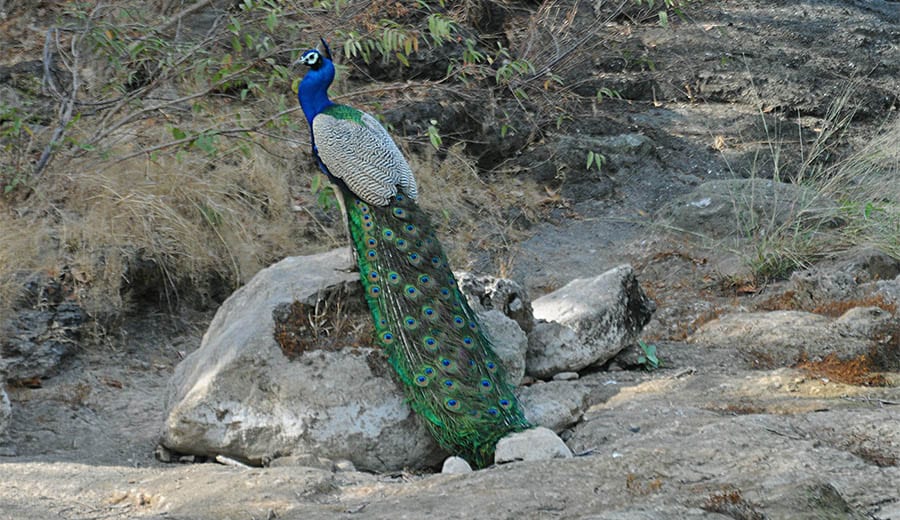Sasan Gir National Park
Sasan Gir National Park is one of the most famous national parks in India owing to the huge presence of an Asiatic lion. It is the only habitat in which the Asiatic lion still survives. It has already been declared as endangered species. Owing to this very reason, tourists often flock to this national park in order to catch a glimpse of this species of lion. The national park is spread over 1412 km². It received the title of a wildlife sanctuary in 1965 and it was declared as a national park in 1975. Overall, if you look at the presence of wildlife in this national park, you would realize that it consists of 438 species of mammals and also 300 species of birds followed by 37 different species of reptiles and over 2000 different species of insects. The authorities have made it easy for you to explore the national park with the help of the jeep safari which is conducted almost on a daily basis.
What constitutes the flora, fauna, and avifauna?
Spreading over an area of 1,1412sq km, the Gir National Park supports a very rich and diverse flora and fauna. The flora of the park chiefly consists of tropical dry deciduous forests of teak trees, rolling grasslands, and semi-evergreen riverine. Major trees include teak and banyan. The main species of trees found here are Jambu, Karanj, Umro, Vad, Kalam, Charal, Sirus, and Amli.
There are about 38 species of mammals, 300 species of birds, and 37 species of reptiles. The main animal inmates of the park are Asiatic lions, leopards, jungle cats, hyenas, mongooses, Chital, Nilgai (Blue bull), four-horned antelope, Chinkara, and wild boar.
The avifauna population includes king vulture, crested serpent eagle, Bonelli’s eagle, crested hawk-eagle, Brown Fish owl, Indian grey hornbill, Pygmy woodpecker, blossom-headed parakeet, Honey-buzzard, spoonbill, raptors, flamingo, spotted dove, crested swift, black-headed oriole, Indian Pitta, etc.
History of Sasan Gir National Park
Gir National Park has a rich history dating back to the late 19th and early 20th centuries. The area was initially a hunting ground for the local Maharajas and British colonial officials. In 1900, the Nawab of Junagadh, who ruled over the region, recognized the importance of protecting the Asiatic Lion and established a hunting ban in the area.
In 1913, the Indian government established the Gir Forest Reserve to protect the remaining lions and their habitat. However, the population continued to decline due to hunting, disease, and loss of habitat. In 1965, the Gir Forest Reserve was declared a national park, and the Indian government launched a conservation program to protect the lions.
The conservation efforts have been successful, and the lion population has increased from a low of around 20 individuals in the 1920s to around 600 today. The park also supports a significant population of other wildlife and is considered an important biodiversity hotspot.
In recent years, the park has been open to visitors and eco-tourism activities are being promoted to generate livelihood opportunities for local communities and also to create awareness about the conservation of wildlife.
Eco-Tourism
Eco-tourism is a form of tourism that focuses on preserving the natural environment and promoting sustainable development. Eco-tourism activities at Gir National Park include guided nature walks, bird watching, wildlife safaris, and jeep tours. These activities are designed to minimize the impact on the environment and provide visitors with an opportunity to learn about the park’s unique ecosystem and the conservation efforts underway.
The park has several designated eco-tourism zones, which are open to visitors during the park’s open season. These zones are managed by the park’s eco-development committees, which are made up of local communities and are responsible for promoting sustainable tourism practices and generating income for the local economy.
Additionally, to make it more sustainable, the park authorities have also put some restrictions on the number of visitors per day, to maintain the balance of human-wildlife interaction. Also, various Eco-friendly measures are implemented such as using solar-powered lamps and electric vehicles inside the park to reduce pollution.
Overall, eco-tourism at Gir National Park provides visitors with an opportunity to learn about the park’s wildlife and conservation efforts while supporting local communities and preserving the environment.
How to Reach Sasan Gir National Park
Gir National Park is located in the Indian state of Gujarat and can be reached by different means of transportation:
- By Air: The nearest airport is Keshod Airport, located about 60 kilometers from the park. Taxis are available from the airport to take visitors to the park.
- By Train: The nearest railway station is Junagadh Junction, located about 55 kilometers from the park. Taxis and buses are available from the railway station to take visitors to the park.
- By Road: The park is well connected by road and can be reached by private or public transportation. There are several buses that run between major cities in Gujarat and the park.
- By Car: Gir National Park is located close to the major cities of Gujarat and can be easily reached by car. It is well-connected to major cities and towns in Gujarat such as Ahmedabad, Rajkot, and Junagadh.
Additionally, you can also take guided tours from nearby cities like Ahmedabad and Rajkot, which will include transportation and accommodation.
It is advisable to plan and book your trip in advance, as the park has restrictions on the number of visitors per day to maintain the balance of human-wildlife interaction.
Best time to Visit
The best time to visit Gir National Park is from mid-October to mid-June. During this period, the weather is pleasant and the park is open to visitors. The monsoon season, which runs from June to September, can make it difficult to spot wildlife and the park is closed during this time.
The months of November to February are the best time to spot lions as they are more active during the winter months. During this time, the grass is shorter, making it easier to spot the lions.
The months of March to May are the best time to see a variety of migratory birds, as well as a wide range of resident birds. It is also a good time to spot other wildlife as the park is lush and green, providing plenty of cover for animals.
It is always recommended to check the park’s official website or contact the park authorities for the exact timings and rules, as the park’s opening and closing timings may change depending on the year and park management decisions.
Best Place to stay
There are several options for accommodation near Gir National Park, including:
- Forest Rest Houses: These are government-run guesthouses located inside the park, which offer basic amenities and are managed by the forest department. These are considered as the best option for those who want to be close to the park and wildlife.
- Gir National Park Resorts: There are several private resorts located near the park, which offer comfortable accommodations and amenities such as air conditioning, swimming pools, and restaurants. Some of the popular resorts in the area include The Gir Birding Lodge, The Gateway Hotel Gir Forest, and The Gir Forest Retreat.
- Homestays: There are several homestays located in the nearby villages that offer a chance to experience the local culture and lifestyle. These homestays offer basic amenities and are a good option for budget travelers.
- Tent accommodations: There are also a few tent accommodations available in the park, which offer a unique experience of camping in the wild. These tents come equipped with basic amenities and offer a chance to be close to nature and wildlife.
It is recommended to book your accommodation in advance, as the park’s opening and closing timings may change depending on the year and park management decisions. Additionally, it is also advisable to check the reviews of the place before booking, to get an idea of the services and amenities offered.
Near-by Attractions
In addition to Gir National Park, there are several other attractions in the area that visitors can explore:
- Junagadh: A historic city located 55 kilometers from the park, Junagadh is known for its monuments, temples and palaces, including the Uparkot Fort, the Ashokan Rock Edicts, and the Mahabat Maqbara.
- Sasan Gir: A small town located near the park, Sasan Gir is known for its wildlife sanctuary and is a popular spot for bird watching.
- Devalia Safari Park: A wildlife park located near the park, Devalia Safari Park is home to a variety of animals including lions, leopards, and crocodiles.
- Kamleshwar Dam: A dam located near the park, Kamleshwar Dam is a popular spot for picnics and offers a chance to spot a variety of birds and other wildlife.
- Kankai Temple: A temple located near the park, Kankai Temple is known for its beautiful architecture and is a popular spot for religious tourism.
- Talala Gir: A nearby town known for its temples, Talala Gir is a good place to visit for those interested in religious tourism.
- Jambughoda Wildlife Sanctuary: A wildlife sanctuary located around 100 km from Gir National Park, Jambughoda Wildlife Sanctuary is a great place to spot a variety of animals and birds.
- Somnath: A famous temple city located around 100 km from Gir National Park, Somnath is known for its beautiful beaches and temples.
Visitors can plan and visit these nearby places to make the most of their trip to Gir National Park.
Safari time and Details
The Gir National Park offers two types of safari options for visitors:
- Lion Safari: This safari takes visitors on a tour of the park in a specially designed open-top jeep, where they can spot lions and other wildlife. The safari is usually conducted twice a day, in the morning and evening, and lasts for about 2-3 hours. Visitors are required to book the safari in advance and the cost of the safari varies depending on the season.
- Gir Interpretation Zone: This safari is for visitors who want to explore the park on foot, accompanied by a guide. The safari is conducted in the morning and lasts for about 3-4 hours. Visitors can spot a variety of wildlife and learn about the park’s flora and fauna. The cost of the safari varies depending on the season.
It is always recommended to check the park’s official website or contact the park authorities for the exact timings and rules, as the park’s opening and closing timings may change depending on the year and park management decisions. Visitors need to carry a government-issued ID card, and the park authorities may also ask for proof of accommodation while entering the park.
It is also important to note that visitors must follow the rules and guidelines set by the park authorities to ensure the safety of both visitors and wildlife. Visitors should also be aware that sightings of wildlife cannot be guaranteed, as animals are wild and their movements cannot be predicted.



